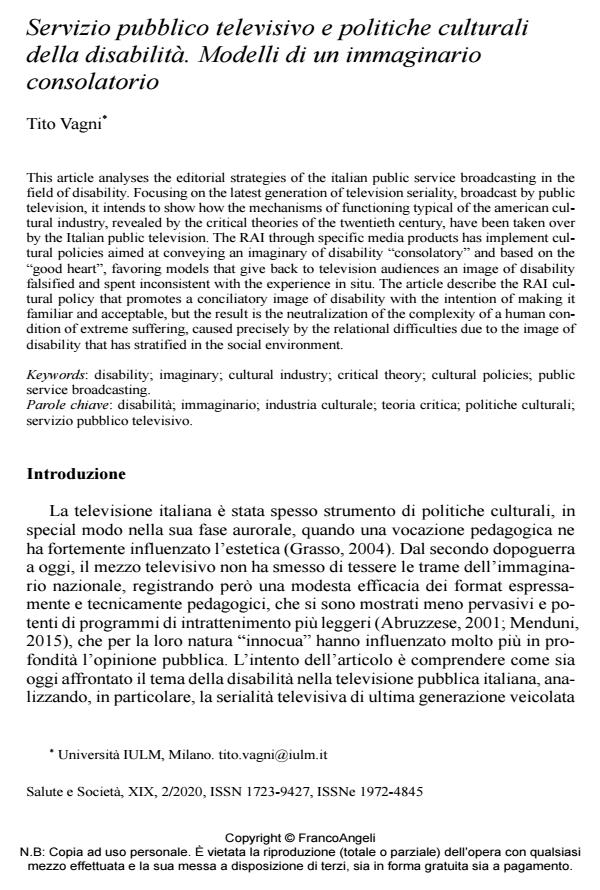Servizio pubblico televisivo e politiche culturali della disabilità. Modelli di un immaginario consolatorio
Journal title SALUTE E SOCIETÀ
Author/s Tito Vagni
Publishing Year 2020 Issue 2020/2
Language Italian Pages 15 P. 56-70 File size 153 KB
DOI 10.3280/SES2020-002005
DOI is like a bar code for intellectual property: to have more infomation
click here
Below, you can see the article first page
If you want to buy this article in PDF format, you can do it, following the instructions to buy download credits

FrancoAngeli is member of Publishers International Linking Association, Inc (PILA), a not-for-profit association which run the CrossRef service enabling links to and from online scholarly content.
This article analyses the editorial strategies of the italian public service broadcasting in the field of disability. Focusing on the latest generation of television seriality, broadcast by publictelevision, it intends to show how the mechanisms of functioning typical of the american culturalindustry, revealed by the critical theories of the twentieth century, have been taken overby the Italian public television. The RAI through specific media products has implement culturalpolicies aimed at conveying an imaginary of disability "consolatory" and based on the"good heart", favoring models that give back to television audiences an image of disabilityfalsified and spent inconsistent with the experience in situ. The article describe the RAI culturalpolicy that promotes a conciliatory image of disability with the intention of making itfamiliar and acceptable, but the result is the neutralization of the complexity of a human conditionof extreme suffering, caused precisely by the relational difficulties due to the image ofdisability that has stratified in the social environment.
Keywords: Disability; imaginary; cultural industry; critical theory; cultural policies; publicservice broadcasting.
- Abruzzese A. (2001). L’intelligenza del mondo. Fondamenti di storia e teoria dell’immaginario. Roma: Meltemi.
- Ang I. (2013). Whatching Dallas. Cultura di massa e imperialismo culturale. Roma: Armando (ed. orig. 1985).
- Baudrillard J. (1996). Il delitto perfetto. La televisione ha ucciso la realtà?. Milano: Raffello Cortina.
- Berger R. (1977). La tele-fissione. Allarme alla televisione. Roma: Edizioni paoline.
- Brancato S. (2003). Serialità. In: Abruzzese A., a cura di, Lessico della comunicazione. Roma: Meltemi.
- Buonanno M. (2006). L’età della televisione. Esperienze e teorie. Bari-Roma: Laterza.
- Buonanno M. (2012). La fiction italiana. Narrazioni televisive e identità nazionale. Bari-Roma: Laterza.
- Bourdon J. (2015). Il servizio pubblico. Storia culturale delle televisioni in Europa. Milano: Vita e Pensiero.
- Caprettini G.P. (2006). Dallas, essere o non essere. In: Dupont F., a cura di, Omero e Dallas. Roma: Donzelli.
- Censis (2010). Le disabilità tra immagini, esperienze e emotività. Roma: Fondazione Censis.
- Durand G. (1994). Le strutture antropologiche dell’immaginario. Bari: Dedalo (ed. orig. 1960).
- De Certeau M. (1980). L’invenzione del quotidiano. Roma: Edizioni Lavoro.
- Eco U. (1978). Il superuomo di massa. Retorica e ideologia nel romanzo popolare. Milano: Bompiani.
- Gozzini G. (2011). La mutazione individualista: Gli italiani e la televisione 1954-2011. Bari-Roma: Laterza.
- Grasso A. (2004). Storia della televisione italiana. Milano: Garzanti.
- Grasso A. (2007). Buona maestra. Perché i telefilm sono diventati più importanti dei libri e del cinema. Milano: Mondadori.
- Horkheimer M., Adorno T. (2010). Dialettica dell’illuminismo. Torino: Einaudi (ed. orig. 1956).
- Lull J. (2003). In famiglia davanti alla tv. Roma: Meltemi (ed. orig. 1990).
- Newcomb H. (1999). La televisione da forum a biblioteca. Milano: Sansoni (ed. orig. 1983).
- McLuhan M. (2011). Gli strumenti del comunicare. Milano: Il Saggiatore (ed. orig. 1964). Menduni E. (2015). Intrattenimento in salsa pedagocica. Un riesame critico della “veterotelevisione” italiana. In: Garofalo D., Roghi V., a cura di, Televisione. Storia, immaginario, memoria. Soveria Mannelli: Rubbettino.
- Mittell J. (2017). Complex TV. Teoria e tecnica dello storytelling delle serie tv. Milano: Minimum Fax (ed orig. 2015).
- Morin E. (2017). Lo spirito del tempo. Roma: Meltemi (ed. orig. 1962).
- Meyrowitz J. (1995). Oltre il senso del luogo. Come i media elettronici influenzano il comportamento sociale. Bologna: Baskerville (ed. orig. 1985).
- Monteleone F. (1996). Storia della radio e della televisione in Italia. Costume, società e politica. Venezia: Marsilio.
- Moores S. (2017). Media, luoghi e mobilità. Milano: FrancoAngeli (ed. orig. 2014).
- Scaglioni M. (2016). Il servizio pubblico televisivo. Morte o rinascita della RAI?. Milano: Vita e Pensiero.
- Vagni T. (2017). Abitare la TV. Teorie, immaginari, reality show. Milano: FrancoAngeli.
Tito Vagni, Servizio pubblico televisivo e politiche culturali della disabilità. Modelli di un immaginario consolatorio in "SALUTE E SOCIETÀ" 2/2020, pp 56-70, DOI: 10.3280/SES2020-002005